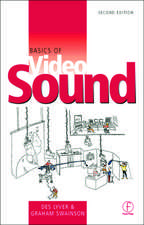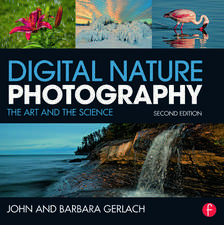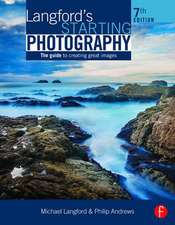Follow the Sun: A Field Guide to Architectural Photography in the Digital Age
Autor James Ewingen Limba Engleză Paperback – 25 oct 2016
Key features include:
• Example photographs and diagrams
• Historical background of architectural photography
• Advice on essential equipment
• How to plan a shoot to your advantage
• How to use tilt-shift lenses for architecture
• Editing workflow and strategies
• Interviews with architectural photographers Peter Aaron, Magda Biernat, Ty Cole, and Elizabeth Felicella.
| Toate formatele și edițiile | Preț | Express |
|---|---|---|
| Paperback (1) | 342.89 lei 3-5 săpt. | +27.55 lei 7-11 zile |
| Taylor & Francis – 25 oct 2016 | 342.89 lei 3-5 săpt. | +27.55 lei 7-11 zile |
| Hardback (1) | 880.05 lei 6-8 săpt. | |
| Taylor & Francis – 25 oct 2016 | 880.05 lei 6-8 săpt. |
Preț: 342.89 lei
Nou
Puncte Express: 514
Preț estimativ în valută:
65.61€ • 68.82$ • 54.62£
65.61€ • 68.82$ • 54.62£
Carte disponibilă
Livrare economică 11-25 martie
Livrare express 25 februarie-01 martie pentru 37.54 lei
Preluare comenzi: 021 569.72.76
Specificații
ISBN-13: 9780415747011
ISBN-10: 0415747015
Pagini: 204
Ilustrații: 99
Dimensiuni: 178 x 254 x 13 mm
Greutate: 0.58 kg
Ediția:1
Editura: Taylor & Francis
Colecția Routledge
Locul publicării:Oxford, United Kingdom
ISBN-10: 0415747015
Pagini: 204
Ilustrații: 99
Dimensiuni: 178 x 254 x 13 mm
Greutate: 0.58 kg
Ediția:1
Editura: Taylor & Francis
Colecția Routledge
Locul publicării:Oxford, United Kingdom
Public țintă
Professional and Professional Practice & DevelopmentCuprins
PART 1: Background
Chapter 1: What is Architectural Photography?
1.1 Who needs architectural images and why?
1.2 Various approaches and styles create subjective visions.
1.3 The photographer’s role as both promoter and critic of the built environment.
Chapter 2: A Brief History
2.1 Influence of Linear Perspective
2.2 The Continuous Evolution of Photographic Tools
2.3 A Timeline of Architectural Photography
2.4 Illustration in Both Analog and Digital Images
PART 2: Planning and Preparation
Chapter 3: The Assignment
3.1 Defining an Assignment
3.2 Self-Assigned Work
3.3 Commissioned Work
3.4 Assignment and Voice
Chapter 4: Know The Site
4.1 Access and Permissions
4.2 Mapping the Site
4.3 Working Shot List
4.4 Site Visit and Revised Shot List
4.5 Scheduling
Chapter 5: Follow the Sun
5.1 Rhythms of Earth and Sun
5.2 Qualities of Light
5.3 Light for Architecture
5.4 Sun Tracking Software
5.5 Chronological Shot List
Chapter 6: The Tools of The Trade
6.1 Camera Support
6.2 Lens
6.3 Camera Body
6.4 Camera Case
6.5 Computers and Storage
6.6 Accessories
6.7 Grip kit
6.8 Lighting
PART 3: The Shoot
Chapter 7: Workflow Onsite
7.1 Shooting Checklist
7.2 Photo Assistant
7.3 Keeping Images Safe
7.4 Shooting Tethered
Chapter 8: Composition
8.1 Formal Elements
8.2 Fundamental Variables
8.3 Cultural Components
8.4 Building a Shot
Chapter 9: Perspective and the Tilt-Shift Lens
9.1 Linear Perspective
9.2 Tilt-Shift Lens and Perspective
9.3 Using a Tilt-Shift Lens for Architecture
9.4 Optimizing Sharpness
9.5 Using a Tilt to Extend Focus
9.6 Breaking the z Axis
Chapter 10: Translating Interior Space
10.1 Identify Goals
10.2 Consider Light and Timing
10.3 Select Camera Position, Lens, and Frame
10.4 Style the Room, Move and Edit Objects
10.5 Adjust Existing Light
10.6 Test, Revise, and Take Final Shot
PART 4: The Final Image
Chapter 11: Post Production Workflow
11.1 Download to Delivery
11.2 Hardware for Post-Production
11.3 Software for Post-Production
11.4 Archiving
11.5 Editing, the Selection Process
11.6 Basic Raw Processing
Chapter 12: Advanced Retouching
12.1 Working with a Professional Retoucher
12.2 How much is too much? Choosing a look
12.3 Lightroom Local Adjustments; Gradients and Brushes
12.4 Compositing with Masked Adjustment Layers
12.5 Lens Corrections
12.6 Spotting and Sharpening
Chapter 13: Presentation
13.1 Editing a Portfolio
13.2 Portfolio Website
13.3 Print Portfolio
PART 5: Work in Action
Chapter 14: Voices From the Field
14.1 Peter Aaron
14.2 Magda Biernat
14.3 Ty Cole
14.4 Elizabeth Felicella
Chapter 1: What is Architectural Photography?
1.1 Who needs architectural images and why?
1.2 Various approaches and styles create subjective visions.
1.3 The photographer’s role as both promoter and critic of the built environment.
Chapter 2: A Brief History
2.1 Influence of Linear Perspective
2.2 The Continuous Evolution of Photographic Tools
2.3 A Timeline of Architectural Photography
2.4 Illustration in Both Analog and Digital Images
PART 2: Planning and Preparation
Chapter 3: The Assignment
3.1 Defining an Assignment
3.2 Self-Assigned Work
3.3 Commissioned Work
3.4 Assignment and Voice
Chapter 4: Know The Site
4.1 Access and Permissions
4.2 Mapping the Site
4.3 Working Shot List
4.4 Site Visit and Revised Shot List
4.5 Scheduling
Chapter 5: Follow the Sun
5.1 Rhythms of Earth and Sun
5.2 Qualities of Light
5.3 Light for Architecture
5.4 Sun Tracking Software
5.5 Chronological Shot List
Chapter 6: The Tools of The Trade
6.1 Camera Support
6.2 Lens
6.3 Camera Body
6.4 Camera Case
6.5 Computers and Storage
6.6 Accessories
6.7 Grip kit
6.8 Lighting
PART 3: The Shoot
Chapter 7: Workflow Onsite
7.1 Shooting Checklist
7.2 Photo Assistant
7.3 Keeping Images Safe
7.4 Shooting Tethered
Chapter 8: Composition
8.1 Formal Elements
8.2 Fundamental Variables
8.3 Cultural Components
8.4 Building a Shot
Chapter 9: Perspective and the Tilt-Shift Lens
9.1 Linear Perspective
9.2 Tilt-Shift Lens and Perspective
9.3 Using a Tilt-Shift Lens for Architecture
9.4 Optimizing Sharpness
9.5 Using a Tilt to Extend Focus
9.6 Breaking the z Axis
Chapter 10: Translating Interior Space
10.1 Identify Goals
10.2 Consider Light and Timing
10.3 Select Camera Position, Lens, and Frame
10.4 Style the Room, Move and Edit Objects
10.5 Adjust Existing Light
10.6 Test, Revise, and Take Final Shot
PART 4: The Final Image
Chapter 11: Post Production Workflow
11.1 Download to Delivery
11.2 Hardware for Post-Production
11.3 Software for Post-Production
11.4 Archiving
11.5 Editing, the Selection Process
11.6 Basic Raw Processing
Chapter 12: Advanced Retouching
12.1 Working with a Professional Retoucher
12.2 How much is too much? Choosing a look
12.3 Lightroom Local Adjustments; Gradients and Brushes
12.4 Compositing with Masked Adjustment Layers
12.5 Lens Corrections
12.6 Spotting and Sharpening
Chapter 13: Presentation
13.1 Editing a Portfolio
13.2 Portfolio Website
13.3 Print Portfolio
PART 5: Work in Action
Chapter 14: Voices From the Field
14.1 Peter Aaron
14.2 Magda Biernat
14.3 Ty Cole
14.4 Elizabeth Felicella
Descriere
Follow the Sun will guide you through all aspects of architectural photography, from the genre’s rich history to the exciting new approaches brought by the advent of the digital age. It explains how to use the powerful tools of digital photography while employing many of the skills and traditions of the established genre. Written to be accessible to professionals, amateurs, and students alike, this book will be useful for photographers exploring architecture as fine artists, on editorial assignments, or on commercial shoots.


















